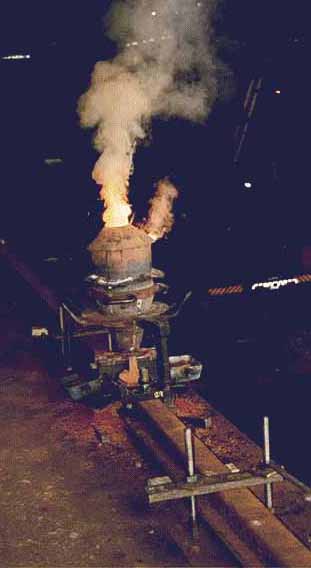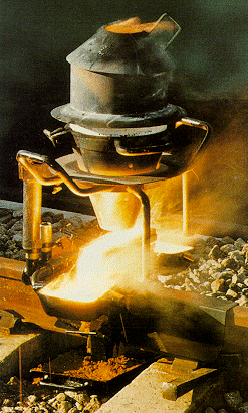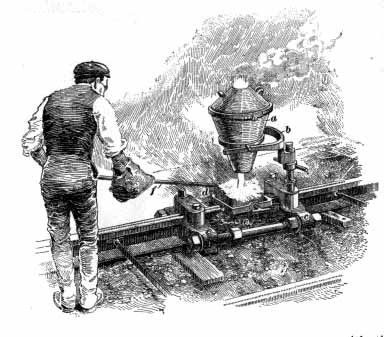|
Thermit Process.-This process of welding metals is effected by pouring superheated thermit steel around the parts
to be united. Thermit is a mixture of finely divided aluminium and iron oxide. This mixture is placed in a crucible
and the steel is produced by igniting the thermit in one spot by means of a special powder, which generates the
intense heat necessary to start the chemical reaction. When the reaction is once started it continues throughout
the entire mass, the oxygen of the iron being taken up by the aluminum (which has a strong affinity for it),
producing aluminum oxide (or slag) and superheated thermit steel. ordinarily, the reaction requires from 35 seconds
to one minute, depending upon the amount of thermit used. As soon as it ceases, the steel sinks to the bottom of
the crucible and is tapped into a mold surrounding the parts to be welded. As the temperature of the steel is
about 5400 degrees F., it fuses and amalgamates with the broken sections, thus forming a homogeneous weld.
It is necessary to pre-heat the sections to be welded before pouring, to prevent chilling the steel.
The principal steps of the welding operation are, to clean the sections to be welded, remove enough metal at
the fracture to provide for a free flow of thermit steel, align the broken members and surround them with
a mold to retain the steel, pre-heat by means of a gasoline torch to prevent chilling the steel, ignite the
thermit and tap the molten steel into the mold. This process is especially applicable to the welding of large
sections. It has been extensively used for welding locomotive frames, broken motor casings, rudder- and sternposts
of ships, crankshafts, spokes of driving wheels, connecting rods, and heavy repair work in general. One of the
great advantages of the thermit process is that broken parts can usually be welded in place. For example,
locomotive frames are welded by simply removing parts that would interfere with the application of a suitable mold.
Thermit is also used for pipe welding, rail welding, and in foundry practice, to prevent the “piping” of ingots.
Preparation of Part to be Welded.?The first step in the operation of thermit welding is to clean the fractured parts
and cut away enough metal to insure an manufactured flow of the molten thermit. The oxy-acetylene or oxy-hydrogen
cutting torch is very efficient for this operation. The amount that should be cut away depends upon the size of
the work. Assuming that a locomotive frame is to be welded, the space should be about 3?4 inch wide for a small
frame, and 1 inch wide for a large frame. The frame sections are then jacked apart about 1?4 inch to allow for
contraction of the weld when cooling; trammel marks are scribed on each side of the fracture to show the normal
length. If the weld is to be made on one member of a double-bar frame, the other parallel member should be heated
with a torch to equalize the expansion in both sections and prevent unequal strains. Mold for Thermit Welding.?
The mold surrounding the fractured part should be so arranged that the molten thermit will run through a gate to
the lowest part of the mold and rise through and around the parts to be welded into a large riser. The accompanying
illustration shows a mold applied to a locomotive frame that is broken between the pedestals at A. The thermit steel
is poured through gate B, and rises into space C after passing around and between the ends of frame F. The mold must
allow for a reinforcing band or collar of thermit steel to be cast around the ends to be welded. Space G, for
forming this collar, and the opening between the frame ends, must be filled before ramming up the mold. Yellow
wax is ordinarily used for this purpose. The shape of this band or collar should be as indicated by the view of
the completed weld at D. The thickest part is directly over the fracture and the band overlaps the edges of the
fracture at least one inch.
For a frame of average size, the collars are made about 4 inches wide and 1 inch thick at the center, the thickness
being increased for comparatively large sections. An opening is also made at E for pre-heating the ends to be welded.
Patterns for the riser, pouring and heating gates can be made of wood. The riser C should be quite large because
the steel that first enters the mold is chilled somewhat by coming into contact with the metal, even when pre-heated.
This chilling effect is overcome by using enough thermit steel to force the chilled portion up into the riser and
replacing it by metal which has practically the full temperature received during reaction. The mold must be made of
a refractory material, owing to the intense heat. The best material is made of one part fire sand, one part fire-clay
and one part ground firebrick, thoroughly mixed while dry and moistened just enough to pack well. If these
ingredients cannot be obtained, one part fire-clay and one part clean, dry sand may be used. When the mold and box
are filled and tamped. the wooden runner and riser patterns are withdrawn. The mold is then ready for the pre-heating
and drying operation which causes the wax matrix to melt and run out. Thermit Required for Welding.?The quantity of
thermit required for making a weld can be determined from the cubic contents of the weld. Calculate the cubic
contents of the weld and its reinforcement in cubic inclines; double this amount to allow for filling the gate and
riser, and multiply by 0.56 to get the number of pounds of thermit required. When wax is used for filling, the weight
of the thermit can be determined as follows: Weigh the wax supply before and after filling the fracture.
The difference in weight (in pounds, or the quantity used, multiplied by 32 will give the weight of thermit
in pounds.
Thermit Additions.?When a quantity of more than 10 pounds of thermit is to be used, add 10 per cent of steel
punchings (not over 1?2 inch in diameter) or steel scrap, free from grease, into the thermit powder. If the thermit
When welding a frame broken as shown in the illustration previously referred to, the screw jack used for forcing
the pedestals apart should be turned back somewhat to release the pressure gradually as the weld cools. After pouring,
the mold should remain in place as long as possible (preferably 10 or 12 hours) to anneal the steel in the weld, and,
in any case, it should not be disturbed for at least two hours after pouring. When welding a broken spoke in
a driving wheel, or a similar part, it is necessary to preheat the adjacent spokes in order to prevent undue
strains due to expansion and contraction. If a section of a spoke is broken out, it can be cast in, but if the
space is over 6 inches long, it is better to insert a piece of steel and make a weld at each end. Owing to the high
temperature 5400 degrees F.) and the violent ebullition of thermit during reaction, the crucible must be lined with
a very refractory material. The crucibles used for this purpose have a sheet-iron shell and are lined with magnesia.
Filling Shrinkage Holes and Surface Flaws.?The filling of surface flaws in castings and forgings usually requires
from 2 to 10 pounds of thermit. To make a weld of this kind, place an open mold around the part to be filled, large
enough to overlap it about 1-2 inch. Clean the hole thoroughly and heat to a red heat by means of a strong blow-torch.
Use eighteen ounces of thermit for each cubic inch of space to be filled, but do not use less than two pounds for
any one weld. Place a small amount of thermit in the crucible which, in this case, is of a small size for hand use.
Ignite the thermit with ignition powder and as soon as it begins to burn, add the remainder, feeding it fast enough
to keep the combustion going. When the reaction is completed, quickly pour the slag (which is about three-fourths
of the total liquid) into dry sand; then pour the steel into the open mold and sprinkle loose thermit on top to
prolong the reaction, as the casting, even when pre-heated, will have a chilling effect on the steel.
Composition of Thermit Steel._An average analysis of thermit steel is as follows: carbon, 0.05 to 0.10 per cent;
manganese, 0.08 to 0.10 per cent; silicon, 0.09 to 0.20 per cent; sulphur, 0.03 to 0.04 per cent; phosphorus,
0.04 to 0.05 per cent; aluminum, 0.07 to 0.18 per cent. The tensile strength is about 65,000 pounds per square inch.
High- and Low-pressure Torches.-The difference between high- and low-pressure welding and cutting torches, according
to the generally accepted meaning of the term, is in the pressure of the acetylene. The first oxy-acetylene torches
developed by Fouche were of the high-pressure type, using acetylene dissolved in acetone. Later, he developed a
lowpressure torch, working on the injector principle, acetylene being drawn into the carburetor chamber where
it mixed with the oxygen. The high pressures originally employed in the first torches could not be safely employed
with the acetylene produced in generators, because the safe pressure of acetylene in volume should never exceed from
15 to 20 pounds per square inch, and the pressure is limited to 25 pounds per square inch by the Underwriters’
Association in the United States: hence, the medium pressure which is in general use was developed. The proportion
of oxygen to acetylene varies somewhat in the different torches. Usually from 1.04 to 1.12 times more oxygen is
consumed than acetylene. Welders and cutters should be provided with goggles or spectacles fitted with approved
colored lenses that protect the eye from destructive light rays, flying sparks and globules of molten metal.
|


